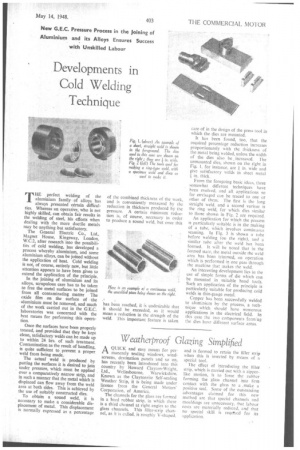Developments in Cold Welding Technique
Page 37

If you've noticed an error in this article please click here to report it so we can fix it.
THE perfect welding of the aluminium family of alloys has always presented certain difficulties. Whereas an operative, who is not highly skilled, can obtain fair results in the welding of steel, his efforts when dealing with the more ductile metals may be anything but satisfactory.
The General Electric Co., Ltd., Magnet House, Kingsway, London, W.C.2, after research into the possibilities of cold welding, has developed a process whereby aluminium, and some aluminium alloys, can be joined without the application of heat. Cold welding is not, of course, entirely new, but little attention appears to have been given to extend the application of the principle.
In the joining of aluminium and its alloys, scrupulous care has to be taken to free the metal surfaces to be joined ' from all contaminating matter The oxide film on the surface of the aluminium must be removed, and much of the work carried out in the G.E.C. laboratories was concerned with the best means for performing this operation.
Once the surfaces have been properly treated, and provided that they be kept clean, satisfactory welds can be made up to within 24 hrs. of such treatment. Contamination as the result of handling, is quite sufficient to prevent a proper weld from being made.
The actual weld is produced by putting the surfaces it is desired to join under pressure, which must be applied over a comparatively narrow strip, and in such a manner that the metal which is displaced can flow away from the weld area at both sides. This is achieved by the use of suitably constructed dies.
To obtain a sound weld, it is necessary to make a considerable displacement of metal. This displacement is normally expressed as a percentage of the combined thickness of the work, and is conveniently measured by the reduction in thickness produced by the pressure. A certain minimum reduction is, of course, necessary in order to produce a sound weld, but once this has been reached, it is undesirable that it should be exceeded, as it would mean a reduction in the strength of the weld. This important feature is taken care of in the design of the press tool in which the dies are mounted.
It has been found, too, that the required percentage reduction increases proportionately with the thickness of the metal being welded, unless the width of the dies also be increased. The unmounted dies, shown on the right in Fig. I, for instance, are in. wide and give satisfactory welds in sheet metal in. thick.
From the foregoing basic ideas, three somewhat different techniques have been evolved, and all applications so far envisaged can be traced to one or other of them. The first is the long straight weld, and a second variant is the ring weld, for which dies similar to those shown in Fig. 2 are required.
An application for which the process is particularly suitable is in the making of a tube, which involves continuous seaming. In Fig. 3 is shown a tube before welding (on the right), and a similar tube after the weld has been formed. It will be noted that in the formed state, the metal outside the weld area has been trimmed, an operation which is performed in one pass through the machine that makes the weld.
An interesting development lies in the use of simple forms of die which can be mounted in suitable hand tools. Such an application of the principle is particularly suitable for producing cold welds in thin-gauge metal.
Copper has been successfully welded to aluminium by the process, a technique which should have numerous applications in the electrical field. In this case the two components forming the dies have different surface areas.




















































































